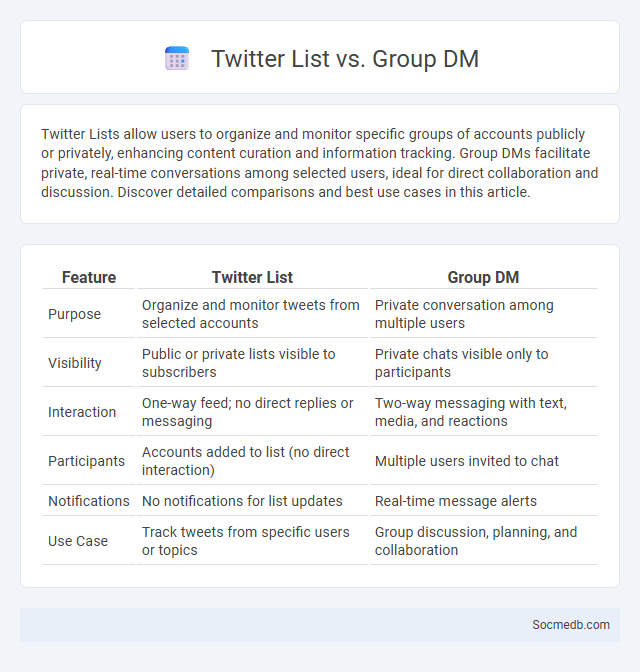
Photo illustration: Twitter List vs Group DM
Twitter Lists allow users to organize and monitor specific groups of accounts publicly or privately, enhancing content curation and information tracking. Group DMs facilitate private, real-time conversations among selected users, ideal for direct collaboration and discussion. Discover detailed comparisons and best use cases in this article.
Table of Comparison
| Feature | Twitter List | Group DM |
|---|---|---|
| Purpose | Organize and monitor tweets from selected accounts | Private conversation among multiple users |
| Visibility | Public or private lists visible to subscribers | Private chats visible only to participants |
| Interaction | One-way feed; no direct replies or messaging | Two-way messaging with text, media, and reactions |
| Participants | Accounts added to list (no direct interaction) | Multiple users invited to chat |
| Notifications | No notifications for list updates | Real-time message alerts |
| Use Case | Track tweets from specific users or topics | Group discussion, planning, and collaboration |
Introduction to Twitter List, Group DM, and List
Twitter Lists organize users into curated groups, allowing you to follow specific topics or interests without cluttering your main feed. Group DMs enable private conversations with multiple users simultaneously, facilitating focused discussions and collaboration. Using Lists and Group DMs can enhance your social media experience by streamlining interactions and managing content more effectively.
Definitions: Twitter List, Group DM, and General Lists
Twitter Lists are curated groups of Twitter accounts organized by topics, enabling you to streamline content consumption and monitor specific interests efficiently. Group DMs on Twitter allow private messaging among multiple users, facilitating focused conversations and enhanced collaboration within select communities. General Lists refer to categorized collections of contacts or accounts across various social media platforms, helping you organize and access relevant information or interactions swiftly.
Purpose and Use Cases of Twitter Lists
Twitter Lists serve as a powerful organizational tool enabling users to categorize accounts into specific groups for streamlined content consumption and enhanced engagement. They facilitate targeted information curation by allowing users to monitor tweets from selected accounts without the noise of a full timeline, supporting use cases such as industry tracking, competitor analysis, and community building. Marketers and social media managers leverage Twitter Lists to efficiently monitor trends, influencers, and customer feedback, boosting strategic decision-making and real-time responsiveness.
Group DM: Features and Best Practices
Group DM on social media platforms offers real-time messaging, multimedia sharing, and customizable notifications, enhancing collaborative communication among multiple users. Features such as message threading, file sharing, and read receipts improve organization and transparency, fostering efficient group interactions. Best practices include setting clear group rules, moderating discussions to maintain respect, and utilizing pinned messages to highlight important information for all participants.
Differences Between Twitter Lists and Group DMs
Twitter Lists allow you to organize and monitor specific groups of users without notifying them, providing a curated timeline tailored to your interests. Group DMs enable private conversations with multiple participants simultaneously, facilitating direct interaction and collaboration. Understanding these differences helps you leverage social media more effectively for both content curation and real-time communication.
Privacy and Visibility: Lists vs. Group DMs
Social media platforms offer distinct privacy and visibility controls through lists and group DMs, allowing you to tailor your audience effectively. Lists enable categorizing followers for targeted content sharing without alerting others, enhancing privacy and content control. Group DMs create a private space for real-time communication among specific users but require careful selection to maintain confidentiality.
Collaboration and Networking Capabilities
Social media platforms enhance your collaboration and networking capabilities by connecting professionals across diverse industries, enabling real-time communication and idea exchange. These tools facilitate the formation of strategic partnerships and foster communities where knowledge sharing drives innovation. Leveraging social media networks accelerates project development and expands your professional influence globally.
Content Organization and Management
Effective content organization and management on social media involve strategic categorization, scheduling, and consistent curation of posts to maximize audience engagement and brand visibility. Utilizing tools like content calendars and management platforms ensures your social media assets are systematically aligned with marketing goals and target demographics. Prioritizing content themes and analytic insights enables you to refine messaging and optimize reach across multiple social networks.
Pros and Cons: Twitter Lists, Group DMs, and Lists
Twitter Lists organize users into curated groups, enhancing content discovery and streamlining your feed to focus on specific interests or communities. Group DMs foster private, direct communication among selected users, enabling efficient collaboration and confidential discussions. However, Twitter Lists may miss real-time updates, and Group DMs can become cluttered or exclude wider audience participation, limiting broader engagement.
Choosing the Right Tool for Your Twitter Strategy
Selecting the ideal social media management tool for your Twitter strategy enhances scheduling efficiency, audience engagement, and analytics tracking. Platforms like Hootsuite, Buffer, and Sprout Social offer tailored features such as automated posting, hashtag research, and real-time performance metrics to optimize content reach and user interaction. Integrating these tools streamlines workflow, enabling data-driven decisions that boost follower growth and brand visibility on Twitter.
 socmedb.com
socmedb.com